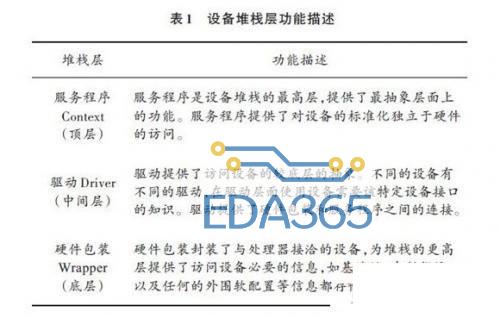platform总线是一种虚拟的总线,相应的设备则为platform_device,而驱动则为platform_driver。Linux 2.6的设备驱动模型中,把I2C、RTC、LCD等都归纳为platform_device。
总线将设备和驱动绑定,在系统每注册一个设备的时候,会寻找与之匹配的驱动;相反的,在系统每注册一个驱动的时候,会寻找与之匹配的设备,而匹配由总线完成。
Linux2.6系统中定义了一个bus_type的实例platform_bus_type
[cpp] view plain copy
print?
struct bus_type platform_bus_type = {
.name = "platform",
.dev_attrs = platform_dev_attrs,
.match = platform_match, //设备和驱动使用match函数来判断是否匹配
.uevent = platform_uevent,
.pm = PLATFORM_PM_OPS_PTR,
};
[cpp] view plain copy
print?
/* platform_match函数用于匹配总线中的驱动和设备 */
static int platform_match(struct device *dev, struct device_driver *drv)
{
struct platform_device *pdev = to_platform_device(dev);
struct platform_driver *pdrv = to_platform_driver(drv);
/* match against the id table first */
if (pdrv->id_table)
return platform_match_id(pdrv->id_table, pdev) != NULL;
/* fall-back to driver name match */
return (strcmp(pdev->name, drv->name) == 0);
}
platform_match函数首先判断是否由id_table,如果有则使用id_table来进行匹配,否则,判断platform_device和platform_driver成员里的name,如果二者的name字段相同则匹配,如果匹配则调用platform_driver的probe函数。
platform_device结构体的定义
[cpp] view plain copy
print?
struct platform_device {
const char * name; /* 名字 */
int id;
struct device dev;
u32 num_resources; /* 资源总数 */
struct resource * resource; /* 资源 */
struct platform_device_id *id_entry;
};
其中有个重要的成员是resource,是设备的资源信息,如IO地址,中断号等。
[cpp] view plain copy
print?
struct resource {
resource_size_t start; //资源的起始值
resource_size_t end; //资源的结束值
const char *name;
unsigned long flags; //资源的类型,如IORESOURCE_IO,IORESOURCE_MEM,IORESOURCE_IRQ,IORESOURCE_DMA
struct resource *parent, *sibling, *child;
};
有的设备可能有多个资源,通常使用platform_get_resource函数来获取资源
[cpp] view plain copy
print?
/**
* platform_get_resource - get a resource for a device
* @dev: platform device
* @type: resource type
* @num: resource index
*/
struct resource *platform_get_resource(struct platform_device *dev,
unsigned int type, unsigned int num)
{
int i;
for (i = 0; i < dev->num_resources; i++) {
struct resource *r = &dev->resource[i];
if (type == resource_type(r) && num-- == 0)
return r;
}
return NULL;
}
平台设备的注册,使用platform_device_register函数
[cpp] view plain copy
print?
int platform_device_register(struct platform_device *pdev)
{
device_initialize(&pdev->dev);
return platform_device_add(pdev);
}
platform_device_register函数先通过device_initialize函数初始化platform_device的device成员,然后调用platform_device_add向内核添加一个平台设备。
[cpp] view plain copy
print?
int platform_device_add(struct platform_device *pdev)
{
int i, ret = 0;
if (!pdev) /* 如果pdev为空则返回EINVAL */
return -EINVAL;
/* 如果pdev->dev.parent为空则将pdev->dev.parent设置为platform_bus */
if (!pdev->dev.parent)
pdev->dev.parent = &platform_bus;
pdev->dev.bus = &platform_bus_type; /* 设置总线类型 */
if (pdev->id != -1) /* 如果id = -1则表示自动分配name */
dev_set_name(&pdev->dev, "%s.%d", pdev->name, pdev->id);
else
dev_set_name(&pdev->dev, pdev->name);
for (i = 0; i < pdev->num_resources; i++) {
struct resource *p, *r = &pdev->resource[i]; /* 获取资源 */
if (r->name == NULL)
r->name = dev_name(&pdev->dev);
p = r->parent;
if (!p) {
if (resource_type(r) == IORESOURCE_MEM) /* 设置资源类型 */
p = &iomem_resource;
else if (resource_type(r) == IORESOURCE_IO)
p = &ioport_resource;
}
if (p && insert_resource(p, r)) {
printk(KERN_ERR
"%s: failed to claim resource %d\n",
dev_name(&pdev->dev), i);
ret = -EBUSY;
goto failed;
}
}
pr_debug("Registering platform device '%s'. Parent at %s\n",
dev_name(&pdev->dev), dev_name(pdev->dev.parent));
/* 向内核添加一个device */
ret = device_add(&pdev->dev);
if (ret == 0)
return ret;
failed:
while (--i >= 0) {
struct resource *r = &pdev->resource[i];
unsigned long type = resource_type(r);
if (type == IORESOURCE_MEM || type == IORESOURCE_IO)
release_resource(r);
}
return ret;
}
platform_device_add最终调用device_add来完成平台设备的注册。
相反地,如果要注销平台设备则使用platform_device_unregister函数
[cpp] view plain copy
print?
void platform_device_unregister(struct platform_device *pdev)
{
platform_device_del(pdev);
platform_device_put(pdev);
}
platform_device_unregister函数调用platform_device_del函数来注销平台设备
[cpp] view plain copy
print?
void platform_device_del(struct platform_device *pdev)
{
int i;
if (pdev) {
device_del(&pdev->dev);
for (i = 0; i < pdev->num_resources; i++) {
struct resource *r = &pdev->resource[i];
unsigned long type = resource_type(r);
if (type == IORESOURCE_MEM || type == IORESOURCE_IO)
release_resource(r);
}
}
}
platform_device_del函数调用device_del函数来删除平台设备,相应地,要释放资源应调用release_resource函数,前提是资源的类型必须为IORESOURCE_MEM或者IORESOURCE_IO
platform_driver的定义:
[cpp] view plain copy
print?
struct platform_driver {
int (*probe)(struct platform_device *);
int (*remove)(struct platform_device *);
void (*shutdown)(struct platform_device *);
int (*suspend)(struct platform_device *, pm_message_t state);
int (*resume)(struct platform_device *);
struct device_driver driver;
const struct platform_device_id *id_table;
};
device_driver的定义:
[cpp] view plain copy
print?
struct device_driver {
const char *name;
struct bus_type *bus;
struct module *owner;
const char *mod_name; /* used for built-in modules */
bool suppress_bind_attrs; /* disables bind/unbind via sysfs */
const struct of_device_id *of_match_table;
const struct acpi_device_id *acpi_match_table;
int (*probe) (struct device *dev);
int (*remove) (struct device *dev);
void (*shutdown) (struct device *dev);
int (*suspend) (struct device *dev, pm_message_t state);
int (*resume) (struct device *dev);
const struct attribute_group **groups;
const struct dev_pm_ops *pm;
struct driver_private *p;
};
platform_driver结构体有device_driver成员,该成员的各自字段如上所示,device_driver也有probe、remove、shutdown等函数,在平台驱动注册的时候被初始化。
前面说过,当系统中存在有平台设备和平台驱动通过总线的match函数匹配后则会调用platform_driver的probe函数,参数为platform_device,有时候也通过id_table来判断是否匹配。
[cpp] view plain copy
print?
struct platform_device_id {
char name[PLATFORM_NAME_SIZE];
kernel_ulong_t driver_data
__attribute__((aligned(sizeof(kernel_ulong_t))));
};
平台驱动的注册使用platform_driver_register函数
[cpp] view plain copy
print?
int platform_driver_register(struct platform_driver *drv)
{
drv->driver.bus = &platform_bus_type;
if (drv->probe)
drv->driver.probe = platform_drv_probe;
if (drv->remove)
drv->driver.remove = platform_drv_remove;
if (drv->shutdown)
drv->driver.shutdown = platform_drv_shutdown;
if (drv->suspend)
drv->driver.suspend = platform_drv_suspend;
if (drv->resume)
drv->driver.resume = platform_drv_resume;
return driver_register(&drv->driver);
}
先初始化platform_driver里的driver,该driver的类型为device_driver,设置driver的bus为platform_bus_type;设置driver的probe为platform_drv_probe;设置driver的remove为platform_drv_remove;设置driver的shutdown为platform_drv_shutdown;设置driver的suspend为platform_drv_suspend;设置driver的resume为platform_drv_resume,最后调用driver_register函数来注册平台驱动。
相反地,要注销平台驱动的话,使用platform_driver_unregister函数
[cpp] view plain copy
print?
void platform_driver_unregister(struct platform_driver *drv)
{
driver_unregister(&drv->driver);
}
『本文转载自网络,版权归原作者所有,如有侵权请联系删除』
 热门文章
更多
热门文章
更多









